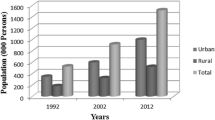Abstract
Changes in eco-environment that are caused by climate changes and human exploitation have been a significant problem around the whole world for a long time. The eco-environment of Iraq is exposed to degradation, particularly in the middle and southern parts. By using an approach that combines remote sensing and GIS, this study examines the changes that have occurred during various periods between 1972 and 2010 in the Tikrit district in Iraq and identifies the factors responsible for the degradation. A significant change was observed in the area covered by vegetation and water, especially between 1990 and 2010, which exacerbated desertification as the vegetation and water area decreased by 16 and 59.6 %, respectively. Also, the urban area increased with varying paces of growth. In the period 1990–2000, the urban area increased by 8.8 % only, which is not surprising considering the population increase. However, between 2000 and 2010, the urban area increased dramatically by 47.5 %, due to the war which led to migration from Baghdad (Iraq Capital) to Tikrit. This study proves that climate change, desertification, and immigration due to wars were the major roles in changing the environment. Also, it reveals that geospatial techniques can be successfully used to monitor the effects on the land cover/ use changes and, hence, on the eco-environment.

Similar content being viewed by others
References
Jabbar, M.T.; Zhou, X.: Eco-environmental change detection by using remote sensing and GIS techniques: a case study Basrah province, south part of Iraq. Environ. Earth Sci. 64(5), 1397–1407 (2011)
Siewe, S.S.: Change detection fnalysis of the landuse and landcover of the Fort Cobb Reservoir Watershed. ProQuest (2007)
Jensen, J.R.: Introductory digital image processing: a remote sensing perspective, 3rd Edn. Prentice Hall, Upper Saddle River (2005)
Lu, D.; Mausel, P.; Brondizio, E.; Moran, E.: Change detection techniques. Int. J. Remote Sens. 25(2), 2365–2401 (2004)
Al-Janabi, K.; Jawad Ali, A.; Al-Taie, F.; Jack, F.: Origin and nature of sand dunes in the alluvial plain of southern Iraq. J. Arid Environ. 14(1), 27–34 (1988)
Dougrameji, J.: Aeolian sediment movements in lower alluvial plain, Iraq. Desert. Control Bull. (35), 45–49 (1999)
Manonmani, R.; Suganya, G.M.D.: Remote sensing and GIS application in change detection study in urban zone using multi temporal satellite. Int. J. Geomat. Geosci. 1(1), 60–65 (2010)
Yang, X.: Satellite monitoirng of urban spatial growth in the Atlanta Metropolitan Area. Photogramm. Eng. Remote Sens. 68(7), 725–734 (2002)
Agarwal, C.: A review and assessment of land-use change models: dynamics of space, time, and human choice. US Forest Service and the Center for the Study of Institutions, Population, and Environmental Change [CIPEC] (2002)
Atiqur, R.; Shiv Prashad, A.; Maik, N.; Shahab, F.: Monitoring urban sprawl using remote sensing and GIS techniques of a fast growing urban centre, India. Appl. Earth Obs. Remote Sens. 4(1), 56–64 (2011)
Lillesand, T.M.; Kiefer, R.W.; Chipman, J.R.: Remote sensing and image interpretation, 5th Edn. John Wiley and Sons Inc., New York (2004)
USGS: Landsat Product Type Descriptions. http://edcsns17.cr.usgs.gov/helpdocs/landsat/product_descriptions.html (2009). Accessed 12 Mar 2012
USGS: Landsat Missions. http://landsat.usgs.gov (2010). Accessed 12 Mar 2012
Laben, C.A.: Process for enhancing the spatial resolution of multispectral imagery using pan-sharpening. US Patent 60118752000
Thapa, R.; Murayama, Y.: Image classification techniques in mapping urban landscape: a case study of Tsukuba city using AVNIR-2 sensor data. Tsukuba Geoenviron. Sci. 3, 3–10 (2007)
Anderson, B.J.R.; Hardy, E.E.; Roach, J.T.; Witmer, R.E.: A land use and land cover classification system for use With remote sensor data. Development (1976)
CCRS: Glossary of remote sensing terms. Canada Centre of Remote Sensing website. http://www.ccrs.nrcan.gc.ca (2005). Accessed 14 July 2011
Jensen, J.R.: Introductory digital image processing, 3rd edn. Prentice Hall, Upper Saddle River (1996)
IAU: Sallah Aldeen Governorate Profile. Inter-Agency Information and Analysis Unit (OCHA) website. http://www.iauiraq.org (2009). Accessed 3 Nov 2012
Author information
Authors and Affiliations
Corresponding author
Rights and permissions
About this article
Cite this article
Hadi, S.J., Shafri, H.Z.M. & Mahir, M.D. Factors Affecting the Eco-Environment Identification Through Change Detection Analysis by Using Remote Sensing and GIS: A Case Study of Tikrit, Iraq. Arab J Sci Eng 39, 395–405 (2014). https://doi.org/10.1007/s13369-013-0859-8
Received:
Accepted:
Published:
Issue Date:
DOI: https://doi.org/10.1007/s13369-013-0859-8




